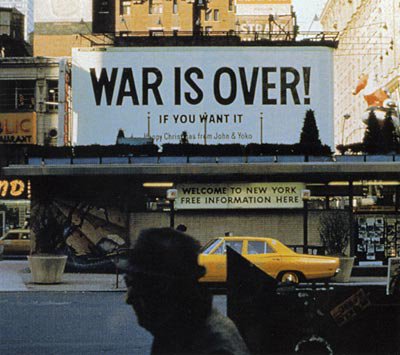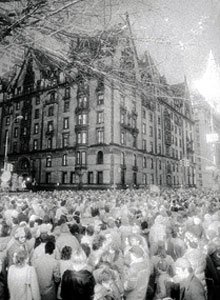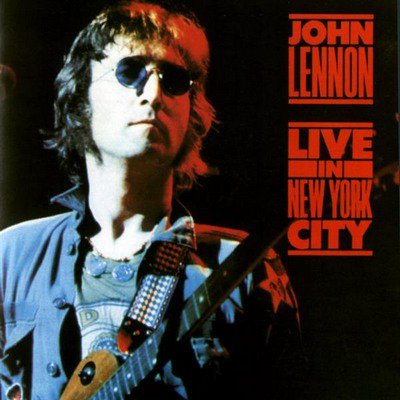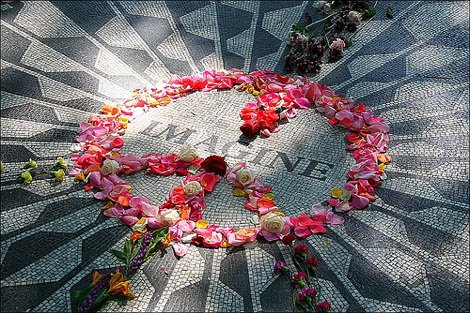December 8th in NYC History
Posted: Dec 8, 2012 | 12:40 AM
1783: American troops celebrate victory for independence.
1894: James Thurber born.
1949: Gentlemen Prefer Blondes, starring Carol Channing, debuted on Broadway and will run another 739 performances. The 1953 film version starred Marilyn Monroe.
1955: Roy Campanella the Brooklyn Dodgers' catcher wins his third American League MVP award.
1962: Newspaper strike.
1980: John Lennon dies. Much more below.
2008: Terrorists confess to planning the 9/11/01 attacks.
Details and reflections:
1783: American troops celebrate victory over the British in the Revolutionary War. They gathered where Parson Boulevard and Jamaica Avenue is in Queens today.
2008: Khalid Sheikh Mohammed and four others confess to masterminding the September 11, 2001 attacks on the World Trade Center and Washington, D.C.
New Yorker Magazine writer and cartoonist James Thurber born 1894. He died in 1961.
1962: A 114-day newspaper strike starts, eventually folding several NYC dailies. The unions won the battles, but they lost the war.

1980: John Lennon was assassinated outside his NYC apartment house, 'the Dakota.' A crowd of people gathered and stood there, singing songs of peace and love.

This was weeks after he came out with the successful "Double Fantasy" album, his first in about five years. The hits "Starting Over," suggested renewal and hope, and "Watching the Wheels," about Lennon's hiatus from the rock world.
The hiatus concluded when Lennon's son, Sean, attended Kindergarten. John left the role of 'househusband' and returned to the studio where he had a creative flourishing. So much that there was enough for another album, the posthumously released "Milk and Honey."
John Lennon first arrived in NYC as "John and Yoko," after the Beatles' triumphant visits in the early to mid 1960s.
He returned: a new New Yorker since around the time of his hit "Imagine" in 1971.
He lived in Greenwich Village on a somewhat funky artsy part of
Jane Street in the far West Village. I think it was #150. He and Yoko were subletting from the leader of the Loving Spoonful band, known for "We lost that loving feeling" and "What's New Pussycat?" A burglar dropped into their house, I think through a skylight! This was alarming, so Lennon and Yoko bought into
the Dakota to be safer, since it has doormen and a heritage of hosting stars such as Judy Garland, Roberta Flak, Ingrid Bergman, Leonard Bernstein, Boris Karloff and others.
It was also the setting of "Rosemary's Baby," about what it is like to share a wall with Satan.
Lennon loved the manic all-night energy of New York City and the relative bonhomie of the "New York Code," which means that fans are supposed to react coolly, but friendly, when sighting stars.
John Lennon in many ways was a typical New Yorker. He came from somewhere else to seek freedom, opportunity and his own identity. In his case, freedom from the British press, and creating his own musical heritage independent of the wildly successful Beatles that he pretty much founded. He was also
an immigrant.
As persecuted as he was from the British press, he faced another ordeal after joining in with political leftists opposing the Vietnam War and CREEP, the Committee to Re-Elect the President, Nixon, along with rightist Senator Strom Thurmond, the FBI,
and the Immigration Service.
(Andy Warhol was persecuted by the IR$ t@x men after he did a poster for Nixon opponent George McGovern, which led to a severe @udit. "The Andy Warhol Diaries," started out as t@x expense diaries for his cab rides in case he was severely audited again. Gradually he chronicled the social scene he was in, and probably threw in a few lies to cause conflicts from the grave, as he did in life.)
As bad as an @udit was for Warhol, the wrath and persistence of the Federal Government was focused on John Lennon for long painful, terrorizing years. The FBI's file on Lennon was larger than it had on all the Nazi fugitives in the United States. There's a movie about it, The US versus John Lennon . His
immigration persecution lasted about four years, and it was lifted in the mid-1970s on 10/9, his birthday and son Sean's, too.
This only bolstered Lennon's belief that 9 was his lucky number, which explains three of his songs with 9 in the title. I wish he made it to 9 December.
Lennon sure earned his right to live in the US, and New York loved him.

Check out the cheers of the Madison Square Garden crowd in his surprise performance on 11/28/1974 with Elton John. I linked to some videos of it, but they don't compare to some of the recordings I heard. It seemed like the roof was going to take off.
But the immigration ordeal stressed him out, as well as being a huge rock star for 15 years. Missing the childhood of his first son, Lennon took on the day to day responsibilities raising his new son.
Every day they would play in the grassy area inside Central Park across from his apartment. On the news of Lennon's death, thousands of fans brought candles, sang songs, and held vigil there for days. Five years later his widow Yoko Ono organized donors from half the world to renovate that part of the park as a peace garden, Strawberry Fields, visited by millions a year.

Central Park was always a highlight of New York City, but it went through decades of abuse and neglect. John and Sean
played in a park full of dust, broken benches and glass, graffitied
trees and rocks.
Five years after Lennon's death, his widow Yoko Ono led people from around 100 countries around the world to renovate
the part of Central Park where he and Sean played daily for years. It was landscaped like a tear drop and beautifully planted. It was named "Strawberry Fields," after a John Lennon hit song during the Beatles days.
The central focus of the garden is the Imagine mosaic. My
sense of John Lennon's legacy in NYC's fabric is that millions of
people visit Strawberry Fields, and therefore Central Park every year.
Strawberry Fields was one of the first parts of Central Park that was renovated by a public-private partnership, giving those who step further inside to experience it much more wonderfulness. John Lennon would be amazed if he could see Central Park today. And he was the inspiration for the renovation of hundreds of acres of Central Parkland.
For me, whose favorite band has been the Beatles since I was a boy, around when John Lennon went into seclusion, the death of John also meant the final true death of the Beatles.
I remember being ten in 1977, having been a Beatles freak since 1975, and listening one night to a cassette. One side was Sergeant Pepper and the other Abbey Road, and after it was over I cried that they broke up.
Little did I know that around that time John Lennon and his
Beatles song writing partner and frenemy Paul McCartney were once laughing, bantering and playing guitar and singing at Lennon's apartment one late Saturday night.
The Beatles members had recently refused Sid Bernstein's offer to reunite for millions of dollars for a single performance, which was then and now a huge amount of money.
To parody this, Lorne Michaels got on his new hit show, Saturday Night Live, and offered the Beatles $3000 (Ringo for free) to reunite.
John and Paul were about to get into a cab and surprise the world but they laughed and forgot to go. Not a surprise considering that the two of them were notoriously huge pot heads. One of the great moments that never was.
How do I know about Lennon in NYC? I created a John Lennon's New York tour for a family in 2009. I am pleased to be running it again this month.
Here's something else that taught me a lot about John Lennon: Recently PBS released John Lennon's American Masters biography of his New York years: LennoNYC It is quite good! Lennon lived in NYC from age 31 to 40. Since Lennon's death, 1 million deaths in the USA involved handguns.
More about this date
http://www.biography.com/on-this-day/december-08
Yet more about this date
http://www.history.com/this-day-in-history/james-thurber-is-born
more
http://learning.blogs.nytimes.com/on-this-day/december-8/